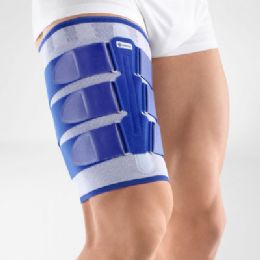



What is a Compression Wrap?
A compression wrap is utilized as therapy for a wide variety of conditions, such as sports injuries, edema, sprains, and varicose veins. When applied to sports injuries, it assists in the reduction of swelling to enable the area to heal faster and to avoid long term issues. There is a wide variety of compression wraps available. Some are long and flexible to wrap around the sprained or swollen area. Others are pre-fabricated wraps made for specific body parts, such as the thigh. Sometimes, these are made of nylon and slip over the affected area or are fastened with Velcro. For extra support, many types have increased bracing in the form of plastic or metal molding. Besides a sprain or sports injury, there are other conditions which improve with proper compression wraps. They can treat leg ulcers and lymphedema, as well as obesity.
How do I Choose the Best Thigh Support?
If one is suffering from upper leg swelling or wanting to support the ligaments and muscles in the thigh during physical activity, a thigh wrap is a good consideration. These are available in a variety of shapes and styles for disparate applications; therefore, it is important to first determine how the support will be used. If compression is desired to support the muscles, a wrap made from neoprene or a similarly tight material is sufficient.
A compression wrap or brace is normally made from rubber, nylon, and/or neoprene. These thigh models may feature hook and loop straps for added security and tightness. Other models may be designed in a cylindrical shape in order to slide over the thigh to provide compression. When choosing a thigh support of this type, it is important to consider how well it will fit on the thigh. A support that is too loose will slide down when moving around and may cause bunching which can lead to discomfort.
For an athlete, breathability is another important consideration when choosing a thigh support. Sweat can build up under some types of materials, which can lead to hot spots, discomfort, or even blisters. As long as the material is breathable, sweat and other types of moisture will pull away from the skin to keep it dry and comfortable throughout the duration of physical activity. If the intended user is not an athlete, breathability will not be an issue if an individual is not very active while wearing the support.
What is an Abduction Support?
An abduction support is a medical recovery device most commonly utilized to keep the legs stable after hip replacement surgery. It is also helpful any time an individual needs to keep the legs still, such as controlling abduction and contractures while in a chair or wheelchair. A variety of procedures and surgeries may require an abduction support for at least a little while in order to facilitate the healing process.
This type of support is normally a foam triangle that is wedged between the legs. It connects to the thighs with soft straps and is intended to be applied while in bed or in a chair. Healthcare providers often require an individual to sleep with this type of support to prevent turning and rolling which can cause damage to new healing tissues. And, depending on the nature of the operation, injury, or condition, an individual may spend most of the day in this device during the early part of a recovery. Although, some time away from the support may be necessary to avoid bedsores or other problems.
Hulet Smith, OT
Rehabmart Co-Founder & CEO
lb